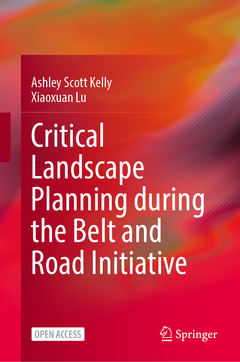Description
Critical Landscape Planning during the Belt and Road Initiative, 1st ed. 2021
Authors: Kelly Ashley Scott, Lu Xiaoxuan
Language: English
Subjects for Critical Landscape Planning during the Belt and Road...:
52.74 €
In Print (Delivery period: 15 days).
Add to cartSupport: Print on demand
Description
/li>Contents
/li>Biography
/li>Comment
/li>
Ashley Scott Kelly is an assistant professor and expert in geographic information systems at the University of Hong Kong. His research and practice focus on scenario-building and filling knowledge gaps for sustainable development, especially in regions that lack adequate knowledge or transparency in development information. He applies design methods to land change and landscape ecology, with wide expertise on the manipulation of geospatial data for the study, advocacy, design, and delivery of projects in ecologically complex and contested landscapes. His recent works include design guidelines for tropical road infrastructure, wildlife corridor modeling, and coupling high-resolution remote sensing with historical narratives for novel impact assessment. He actively engages development and multilateral agencies across Southeast Asia and teaches design courses on regional planning in China, South and Southeast Asia, and Latin America.
Xiaoxuan Lu is an assistant professor in the Division of Landscape Architecture at the University of Hong Kong, where she teaches landscape history and theory, and design studios. Her research focuses on the cultural landscape and geography of conflict, particularly in China and its transboundary regions in Central Asia, Southeast Asia, and Northeast Asia. Applying analytical cartography, photography, and videography in her research, she aims to reveal the hidden layers of landscape where multiple tensions converge. She has received numerous awards for her research and design works, notably an Award of Excellence (2012) and an Honor Award (2015) from the American Society of Landscape Architects, and a commendation for the Cities & Community category (2019) in the Royal Institute of British Architects President's Awards for Research. Xiaoxuan holds the degree of Bachelor of Architecture from Southern California Institute of Architecture, Master in Landscape Architecture from Harvard University, and Ph.D. in Human Geography from PekiTraces the development of landscapes along the 414-kilometer China–Laos Railway
Provides history, planning pedagogy, and interdisciplinary framing for working alongside the often-opaque planning, design, and implementation processes of large-scale infrastructure
Features nine planning proposals for Laos generated through this research initiative since the railway's groundbreaking in 2016
Advocates the cautious engagement of the professionally oriented built-environment disciplines, such as regional planning, civil engineering, and landscape architecture
Is an open access book




